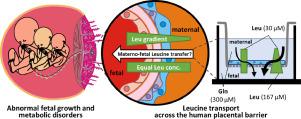The Journal of Nutritional Biochemistry ( IF 4.8 ) Pub Date : 2021-05-06 , DOI: 10.1016/j.jnutbio.2021.108760 Jonas Zaugg 1 , Fabian Ziegler 1 , Jean-Marc Nuoffer 2 , Ruedi Moser-Hässig 3 , Christiane Albrecht 1

|
The developing fetus is highly vulnerable to imbalances in the supply of essential amino acids (AA). Transplacental AA transfer depends on complex interactions between accumulative transporters, exchangers and facilitators, which maintain both intra-extracellular and materno-fetal substrate gradients. We determined physiological AA gradients between maternal and fetal blood and assessed their importance by studying maternal-fetal leucine transfer in human trophoblasts. Maternal-venous and corresponding fetal-arterial/fetal-venous sera were collected from 22 healthy patients at partum. The acquisition of the full AA spectra in serum was performed by ion exchange chromatography. Physiological materno-fetal AA levels were evaluated using paired two-way ANOVA with Tukey's correction. AA concentrations and gradients were tested for associations with anthropometric data by Spearman correlation analysis. Functional effects of a physiological leucine gradient versus equimolar concentrations were tested in BeWo cells using L-[3H]-leucine in conventional and Transwell-based uptake and transfer experiments. The LAT1/SLC7A5-specific inhibitor JPH203 was used to evaluate LAT1-transporter-mediated leucine transport. Maternal AA concentrations correlated with preconceptional and maternal weights at partum. Interestingly, low materno-fetal AA gradients were associated with maternal weight, BMI and gestational weight gain. Leucine uptake was promoted by increased extracellular substrate concentrations. Materno-fetal leucine transfer was significantly increased against a 137µM leucine gradient demonstrating that transplacental leucine transport is stimulated by a counter-directed gradient. Moreover, leucine transfer was inhibited by 10µM JPH203 confirming that Leu transport across the trophoblast monolayer is LAT1-dependent. This study demonstrates a currently underestimated effect of transplacental AA gradients on efficient leucine transfer which could severely affect fetal development.
中文翻译:

逆向亮氨酸梯度促进跨人类胎盘的氨基酸转移
发育中的胎儿极易受到必需氨基酸 (AA) 供应失衡的影响。经胎盘 AA 转移取决于累积转运蛋白、交换剂和促进剂之间的复杂相互作用,它们维持细胞内和母胎底物梯度。我们确定了母体和胎儿血液之间的生理 AA 梯度,并通过研究人类滋养层细胞中的母胎亮氨酸转移来评估它们的重要性。母体静脉和对应胎儿动脉/胎儿-静脉血清从22名健康患者收集产后. 血清中全 AA 光谱的采集是通过离子交换色谱法进行的。使用配对双向方差分析和 Tukey 校正评估生理母胎 AA 水平。通过 Spearman 相关分析测试 AA 浓度和梯度与人体测量数据的关联。在常规和基于 Transwell 的摄取和转移实验中,使用 L-[ 3 H]-亮氨酸在BeWo 细胞中测试生理亮氨酸梯度与等摩尔浓度的功能效应。LAT1/SLC7A5 特异性抑制剂 JPH203 用于评估 LAT1 转运蛋白介导的亮氨酸转运。与preconceptional和产妇的权重相关的产妇AA浓度产后. 有趣的是,低母胎 AA 梯度与母体体重、BMI 和妊娠期体重增加有关。细胞外底物浓度的增加促进了亮氨酸的吸收。相对于 137µM 亮氨酸梯度,母胎亮氨酸转移显着增加,表明经胎盘亮氨酸转运受到反向梯度的刺激。此外,亮氨酸转移受到 10µM JPH203 的抑制,证实 Leu 跨滋养层单层的转运是 LAT1 依赖性的。该研究表明,目前低估了经胎盘 AA 梯度对可能严重影响胎儿发育的有效亮氨酸转移的影响。











































 京公网安备 11010802027423号
京公网安备 11010802027423号